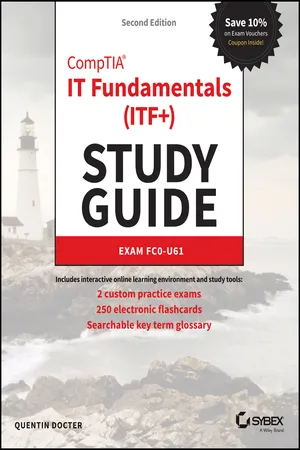
- English
- ePUB (mobile friendly)
- Available on iOS & Android
About this book
NOTE: The name of the exam has changed from IT Fundamentals to IT Fundamentals+ (ITF+). However, the FC0-U61 exam objectives are exactly the same. After the book was printed withIT Fundamentalsin the title, CompTIA changed the name toIT Fundamentals+ (ITF+). We have corrected the title toIT Fundamentals+ (ITF+) in subsequent book printings, but earlier printings that were sold may still showIT Fundamentalsin the title. Please rest assured that the book content is 100% the same. The ultimate study guide for the essential entry-level IT cert!
The CompTIA IT Fundamentals Study Guide: Exam FC0-U61, Second Edition is your ideal companion for comprehensive exam preparation. Covering 100 percent of the latest exam objectives, this book contains everything you need to know to pass with flying colors—the first time! Clear, concise language breaks down fundamental IT concepts to help you truly grasp important concepts, and practical examples illustrate how each new skill is applied in real-world situations. You'll learn your way around hardware and software, conduct installations, and connect to networks to get a workstation up and running smoothly; you'll also develop the knowledge base needed to identify compatibility and security issues, mitigate risks, and conduct all-important preventative maintenance that keeps the end-user problem-free.
The CompTIA IT Fundamentals certification validates your skills as a systems support specialist, and gets your foot in the door to a successful IT career. This book is your ultimate preparation resource, with expert guidance backed by online tools to take your preparation to the next level!
- Master 100 percent of Exam FC0-U61 objectives
- Learn real-world applications and practical on-the-job skills
- Know what to expect with exam highlights and review questions
- Includes 1 year free access to Sybex's online study tools including flashcards, chapter tests, and a practice exam, all supported by Wiley's support agents who are available 24x7 via email or live chat to assist with access and login questions
The IT department is instrumental in keeping any organization on its feet. As support staff, you will be called upon to assess and repair common problems, set up and configure workstations, address individual issues, and much more. If you decide to continue on to more advanced IT positions, the CompTIA IT Fundamentals certification is a great springboard; if you're ready to launch your career, the CompTIA IT Fundamentals Study Guide offers complete, practical prep to help you face the exam with confidence.
Frequently asked questions
- Essential is ideal for learners and professionals who enjoy exploring a wide range of subjects. Access the Essential Library with 800,000+ trusted titles and best-sellers across business, personal growth, and the humanities. Includes unlimited reading time and Standard Read Aloud voice.
- Complete: Perfect for advanced learners and researchers needing full, unrestricted access. Unlock 1.4M+ books across hundreds of subjects, including academic and specialized titles. The Complete Plan also includes advanced features like Premium Read Aloud and Research Assistant.
Please note we cannot support devices running on iOS 13 and Android 7 or earlier. Learn more about using the app.
Information
Chapter 1
Core Hardware Components
- 1.3 Illustrate the basics of computing and processing

- Input
- Processing
- Output
- Storage
- 1.5 Compare and contrast common units of measure

- Storage unit
- Bit
- Byte
- KB
- MB
- GB
- TB
- PB
- Processing speed
- MHz
- GHz
- Storage unit
- 2.3 Explain the purpose of common internal computing components

- Motherboard/system board
- Firmware/BIOS
- RAM
- CPU
- ARM
- Mobile phone
- Tablet
- 32-bit
- Laptop
- Workstation
- Server
- 64-bit
- Laptop
- Workstation
- Server
- ARM
- GPU
- Storage
- Hard drive
- SSD
- Cooling
- NIC
- Wired vs. wireless
- Onboard vs. add-on card
- 2.5 Compare and contrast storage types

- Volatile vs. non-volatile
- Local storage types
- RAM
- Hard drive
- Solid state vs. spinning disk
- Optical
- Flash drive

Introducing Internal Components
- Keeping all the components securely in place
- Protecting the components from harm

Exploring Motherboards, Processors, and Memory
Table of contents
- Cover
- Title Page
- Copyright
- Dedication
- Acknowledgments
- About the Author
- Introduction
- Assessment Test
- Answers to the Assessment Test
- Chapter 1 Core Hardware Components
- Chapter 2 Peripherals and Connectors
- Chapter 3 Computing Devices and the Internet of Things
- Chapter 4 Operating Systems
- Chapter 5 Software Applications
- Chapter 6 Software Development
- Chapter 7 Database Fundamentals
- Chapter 8 Networking Concepts and Technologies
- Chapter 9 Security Concepts and Threats
- Chapter 10 Security Best Practices
- Chapter 11 Business Continuity and Computer Support
- Appendix A Answers to Written Labs
- Appendix B Answers to Review Questions
- Index
- Advert
- End User License Agreement